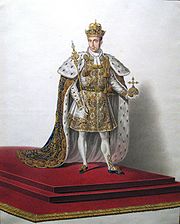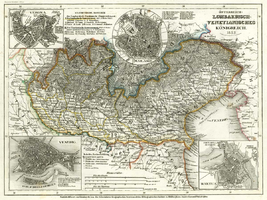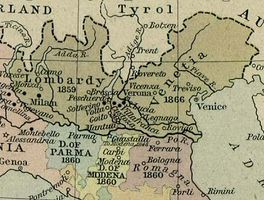Kingdom of Lombardy-Veneto
| Regno Lombardo – Veneto | |||||
| Kingdom of Lombardy-Veneto | |||||
| 1815-1859 / 1866 | |||||
|
|
|||||
| Official language | Italian , German | ||||
| Capital |
Milan (1815-1859),
Venice (1859–1866) |
||||
| Form of government | Royalty (part of the Austrian Empire ) | ||||
| Head of state | King of Lombardy-Veneto | ||||
| Head of government | Viceroy (until 1848), Governor General (from 1850) | ||||
| surface | 47,500 km² | ||||
| population | ~ 5,173,000 | ||||
| Population density | 109 inhabitants per km² | ||||
| currency | 1 Thaler ( Convention Thaler ) = 2 (Austrian) Gulden = 100 Kreutzer = 400 Pfennig = 800 Heller ; from 1857 ( Vienna Coin Agreement ): 1 thaler ( Vereinstaler ) = 1½ gulden = 150 Neukreuzer |
||||
| founding | 1815 ( Congress of Vienna ) | ||||
| resolution | 1866 | ||||
| Area, population: 1857 | |||||
The Kingdom of Lombardo-Veneto (Italian Regno Lombardo-Veneto ) as an amalgamation of Lombardy and Veneto was formed after the Congress of Vienna in 1815 and until 1859/66 a country within the Austrian Empire . The Lombardy-Venetian Kingdom covered an area of 47,500 km² and had around 5,173,000 inhabitants (1857).
history
prehistory
The area was previously part of the Napoleonic Kingdom of Italy (Lombardy and Veneto) or the Cisalpine Republic (Lombardy), which was renamed the Italian Republic on January 26, 1802 and incorporated into the newly created Kingdom of Italy by Napoléon on March 17, 1805 . Veneto was already part of the Habsburg monarchy from 1797 to 1805 . Before the coalition wars, the Habsburg duchies of Milan and Mantua and the Republic of Venice were in the same area.
founding
The Kingdom of Lombardy-Veneto was created on June 9, 1815 as a result of the Congress of Vienna. The official languages were Italian and German. King was in personal union the Emperor of Austria , who was represented by a viceroy from 1815 to 1848 and then by a governor-general . The most famous governors-general were Josef Wenzel Graf Radetzky and Ferdinand Maximilian Joseph Maria of Austria .
Repubblica di San Marco 1848/49
In the course of the revolutionary upheavals of 1848 , which covered almost all of Central Europe , the rebellious Repubblica di San Marco came into being in Venice on March 23, 1848 . The Cinque Giornate uprisings also broke out in Milan (March 18-22). A few weeks later, the Kingdom of Sardinia-Piedmont declared war on Austria and invaded Lombardy. By August the Austrian troops had occupied Milan again, and by the end of 1848 the whole of Veneto had been recaptured. After the victory of the Austrians in the Battle of Novara and the subsequent peace treaty of Milan on August 6, 1849, Venice was conquered by the Austrian military on August 23, 1849 as the last bastion of the northern Italian revolutionaries and republicans .
Division into two crown lands
In 1851 the kingdom was divided into the two crown lands of Lombardy and Veneto , with the name "Kingdom of Lombardy-Veneto" retained until October 3, 1866.
The End
After the defeat in the Sardinian War , Austria had to cede Lombardy to France with the Peace of Villafranca in 1859 . In the Treaty of Turin of 1860 with the Kingdom of Sardinia , the area was exchanged for Nice and Savoy , so that Lombardy became part of the newly formed Kingdom of Italy in 1861 . With the Peace of Vienna in 1866, Veneto and Mantua finally fell to Italy.
Kings of Lombardy-Veneto

Archduke Rainer in the official costume of the Viceroy of Lombardy-Veneto
|
- 1815–1835: Franz I , Emperor of Austria
- 1835–1848: Ferdinand I , Emperor of Austria
- 1848–1866: Franz Joseph I , Emperor of Austria

Viceroys of Lombardy-Veneto
- Prince Henry XV Reuss zu Plauen (1814-1815)
- Count Friedrich Heinrich von Bellegarde (1815–1816)
- Archduke Anton Victor of Austria (1816–1818)
- Archduke Rainer of Austria (1818–1848)
Governors-General of Lombardy-Veneto
- Count Josef Wenzel Radetzky von Radetz (1848–1857)
- Archduke Maximilian of Austria (1857-1859)
- cards
Web links
literature
- Sergio Marinelli, Giuseppe Mazzariol, Fernando Mazzocca (eds.): Il Veneto e l'Austria. Vita e cultura artistica nelle città venete (1814–1866) . Milan 1989.
- Brigitte Mazohl-Wallnig: Austrian administrative state and administrative elites in the Kingdom of Lombardy-Venetia 1815-1859. Zabern, Mainz 1993, ISBN 3-8053-1238-5 .
- Brigitte Mazohl-Wallnig: constitutional question and nationality problem . The example of Lombardy-Veneto. In: Schriften zur Europäische Rechts- und Verfassungsgeschichte 38 (2001) Duncker & Humblot, pp. 366–387.
- Franz Pesendorfer: Iron Crown and Double Eagle. Lombardy-Veneto 1814–1866. Deuticke, Vienna 1992, ISBN 3-216-07949-X .
- Eugen Semrau: Austria's footsteps in Venice. With contributions by Antonio A. Rizzoli and Miguel Herz-Kestranek. Vienna / Graz / Klagenfurt 2010, ISBN 978-3-222-13309-1 .
- Simonatta Soldani: Approaching Europe on behalf of the nation. The Italian Revolution 1846–1849. In: Dieter Dowe , Heinz-Gerhardt Haupt, Dieter Langewiesche (eds.): Europe 1848. Revolution and reform. Dietz, Bonn 1988, ISBN 3-8012-4086-X .
- Alvise Zorzi: Austria's Venice. The last chapter of foreign rule 1798 to 1866. From the Ital. v. Heinz-Georg Held and Claudia Piras. Düsseldorf / Hildesheim 1990, ISBN 3-546-49970-0 , (original under the title Venezia Austriaca . Rom / Bari 1985).
historical monographs:
- Ignaz de Luca: Lombardy. In: Geographisches Handbuch von dem Oestreichischen Staats. 5th volume Galicia, and Lodomeria, together with the Bukowine. Verlag Joseph V. Degen, Vienna 1791, pp. 581-588 ( Google eBook ).
Individual evidence
- ↑ a b Entry on Lombardy-Venetian Kingdom in the Austria Forum (in the AEIOU Austria Lexicon )
- ^ Entry Lombardy. 2) (Milan administrative area of the Lombard-Venetian Kingdom). and 3) Since the Preliminary Peace of Villafranca… In: Lombardy . In: Heinrich August Pierer , Julius Löbe (Hrsg.): Universal Lexicon of the Present and the Past . 4th edition. tape 10 . Altenburg 1860, p. 477-478 ( zeno.org ).
- ^ Change of title , proclaimed January 29, 1869. Franz Gall: Österreichische Wappenkunde . Böhlau, Vienna 1992, p. oA . Quoted from François R. Velde: Royal Styles → Austria. In: Heraldica → Royalty. January 18, 2007, accessed on June 23, 2009 (English, with, German / Latin, original texts).






